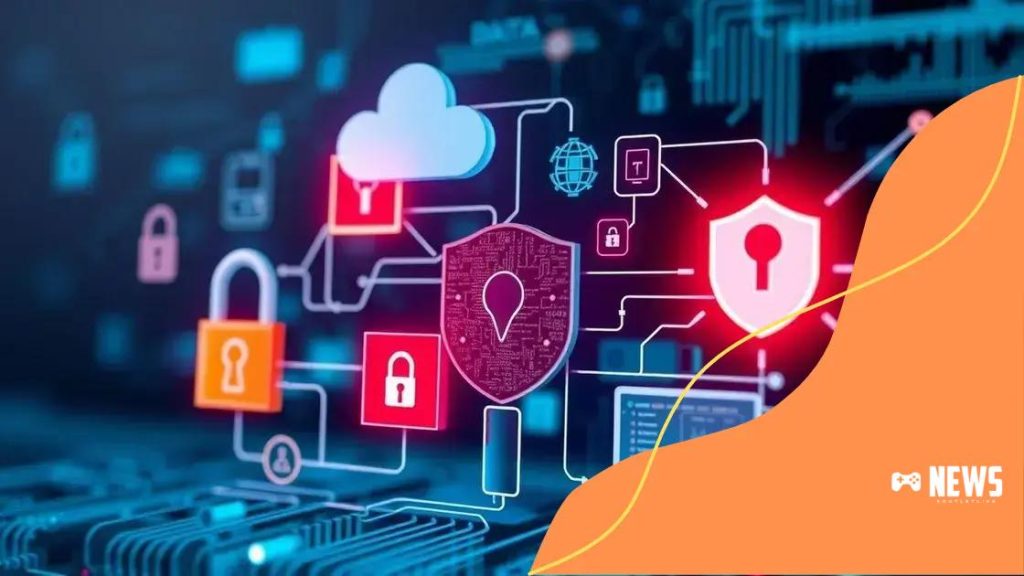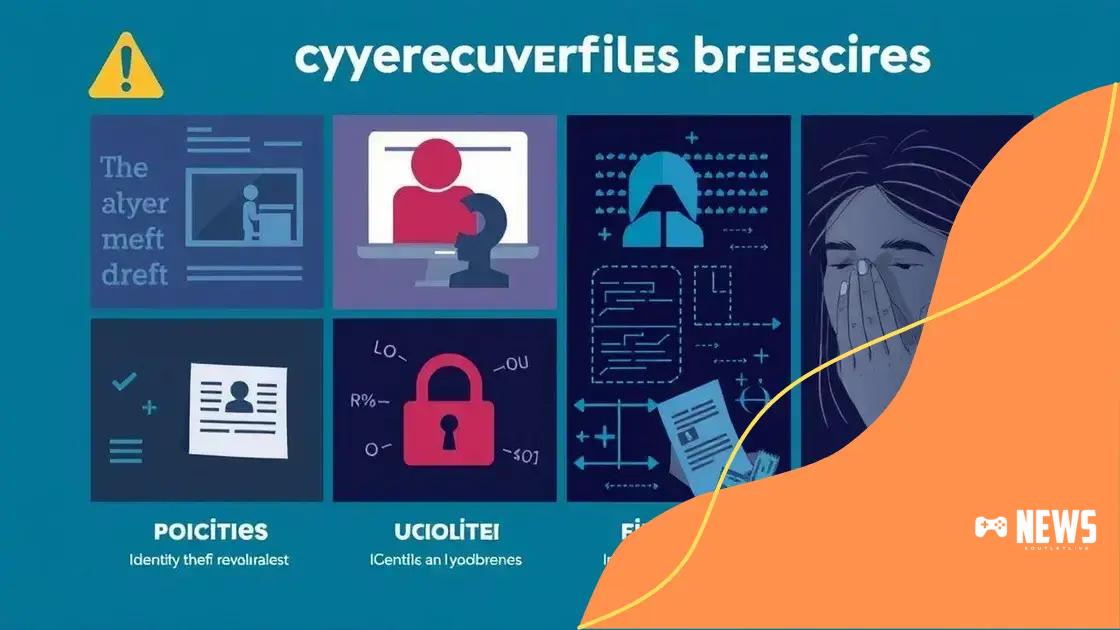Cybersecurity threats: safeguarding your personal data

Cybersecurity threats include malware, phishing, and ransomware, which endanger personal data; using strong passwords, enabling two-factor authentication, and leveraging technology are critical for effective protection.
Cybersecurity threats are becoming increasingly common as we navigate the digital age. With personal data at risk, it’s vital to understand how to safeguard your information. So, how prepared are you?
Understanding cybersecurity threats
Understanding cybersecurity threats is essential in today’s digital world. As people rely more on technology, the risk of these threats increases. Let’s explore what these threats are and how they affect us.
Types of Cybersecurity Threats
There are various types of cybersecurity threats. They can target individuals, companies, and even governments. Some common threats include:
- Malware: Software designed to harm or exploit devices.
- Phishing: Fraudulent attempts to obtain sensitive information.
- Ransomware: A type of malware that locks data until a ransom is paid.
- DDoS attacks: Overloading systems to disrupt services.
Each of these threats has unique characteristics. For example, malware can come in many forms, such as viruses or spyware. Phishing usually involves emails pretending to be trustworthy sources.
How Threats Impact Individuals
The impact of these threats on individuals can be devastating. Many people lose access to their data, while others might have their identities stolen. Understanding these risks is critical. You might be wondering how often this happens. In fact, cybercrime is on the rise, affecting millions of people every year.
It’s essential to recognize the signs of a potential attack. For instance, if you receive an unusual email asking for personal information, it may be a phishing attempt. Always be cautious with your personal data and online interactions.
As we continue to use digital tools, staying informed about cybersecurity threats helps us protect ourselves. Implementing safety measures can significantly reduce the risk of an attack.
Common types of cybersecurity threats
Knowing the common types of cybersecurity threats helps individuals and organizations stay safe online. As technology evolves, so do the methods attackers use. Let’s take a closer look at what these threats are.
Malware
Malware is a broad category that includes different types of harmful software designed to damage or exploit systems. It can take various forms, such as:
- Viruses: Programs that attach themselves to clean files and spread throughout a computer system.
- Worms: These replicate without needing a host file, spreading across networks.
- Spyware: Software that secretly observes user activity and collects information.
Each type of malware poses unique risks, making awareness crucial for protection.
Phishing
Phishing attacks trick individuals into providing sensitive info, such as passwords and credit card numbers. They often come in the form of seemingly legitimate emails. Recognizing these can save you from falling victim:
- Check for suspicious email addresses.
- Look for poor grammar or spelling in messages.
- Be cautious of links that don’t match the company’s official website.
Being vigilant is an effective way to defend against these schemes.
Ransomware
Ransomware is particularly concerning since it locks users out of their data until a ransom is paid. This type of attack usually targets files and impacts organizations severely. Prevention is vital. Regular backups and security software can protect against ransomware attacks.
Understanding these common types of cybersecurity threats equips you with knowledge. The more you know, the better you can protect your personal and sensitive information in an increasingly digital world.
Impact of cybersecurity breaches on individuals

The impact of cybersecurity breaches on individuals can be profound and far-reaching. When personal data is compromised, it can lead to many serious consequences. Understanding these impacts is vital for anyone using technology.
Identity Theft
Identity theft is one of the most significant dangers individuals face after a data breach. Attackers may use stolen information to impersonate someone and access their finances. This can cause not only financial loss but also long-lasting damage to a person’s credit score.
Loss of Privacy
Another major effect is the loss of privacy. Individuals may find their personal information exposed to the public without consent. This invasion can create visible and invisible scars that affect social interactions and self-esteem.
- Monitoring accounts for unusual activities is crucial.
- Consider freezing credit to prevent unauthorized use.
- Stay informed about data breach notifications from organizations.
When individuals have their data exposed, it often leads to fear and anxiety about future security breaches. Cybersecurity breaches can make people more cautious, but this can also lead to unnecessary fear, affecting their online interactions.
Financial Loss
The financial impact can be extensive. After a data breach, victims may face unexpected costs such as:
- Fees for credit monitoring services.
- Costs to recover stolen funds.
- Expenses related to legal actions.
Moreover, individuals may struggle to regain trust in online platforms. This can lead to reluctance in sharing information with companies, hindering conveniences such as online shopping.
Ultimately, the impact of cybersecurity breaches on individuals emphasizes the importance of cybersecurity. Staying informed and proactive is key to mitigating potential risks.
Best practices for protecting personal data
Knowing the best practices for protecting personal data is crucial in our digital age. Each of us carries sensitive information online that needs safeguards. Here are some effective strategies to keep your data safe.
Use Strong Passwords
One of the key steps is to use strong passwords. A strong password typically contains a mix of letters, numbers, and symbols. It is advisable to avoid easily guessable options, like birthdays or common words. Ensure that your password is at least eight characters long, as this makes it harder for cybercriminals to break.
Enable Two-Factor Authentication
Two-factor authentication (2FA) adds an extra layer of protection. This process requires not just a password but also a second piece of information, such as a code sent to your phone. This makes it much more difficult for unauthorized users to access your accounts.
- Always enable 2FA where available.
- Keep your authentication method secure, like using a trusted app.
- Regularly review device access to your accounts.
Being proactive about security helps tremendously. Regularly update your software and applications to protect against potential vulnerabilities.
Be Cautious with Personal Information
Always be cautious about sharing your personal information, especially on social media. Cybercriminals often use this data to execute identity theft or phishing scams. Consider adjusting your privacy settings and limit what you share publicly.
Lastly, consider using encrypted connections, like VPNs, especially on public Wi-Fi networks. This helps shield your online activities from prying eyes.
In summary, adhering to these best practices for protecting personal data can significantly reduce your risk of falling victim to cyber threats. Staying informed and vigilant is your best defense.
The role of technology in cybersecurity
The role of technology in cybersecurity is vital as we face increasing threats in the digital world. Technology not only helps in defending against cyberattacks but also plays a big part in identifying and mitigating risks. Understanding these elements can enhance our safety online.
Advanced Security Software
Using advanced security software is essential. This software can detect and prevent various security threats, such as viruses and malware. Many companies offer solutions that provide:
- Firewall protection: Monitors and controls incoming and outgoing network traffic.
- Antivirus programs: Scans for and removes harmful software.
- Intrusion detection systems: Alerts users to suspicious activity on the network.
Incorporating these technologies into your systems creates a robust defense against potential breaches.
Data Encryption
Data encryption is another important technology in cybersecurity. It transforms data into a code to prevent unauthorized access. This is crucial for protecting sensitive information, especially during transmission over the internet. Encrypted data adds an extra layer of security, making it difficult for hackers to decipher.
Additionally, businesses increasingly rely on cloud technologies to store data. While this improves accessibility, it also raises security concerns. The proper implementation of cloud security practices ensures data remains protected from breaches.
AI and Machine Learning
Artificial Intelligence (AI) and machine learning are revolutionizing cybersecurity. These technologies can analyze vast amounts of data and identify patterns that indicate potential threats. They can adapt and learn from new attack methods, improving detection rates over time.
Implementing AI-driven tools can lead to faster response times and better security measures. Organizations that harness the power of technology position themselves to defend against ever-evolving cyber threats effectively.
In conclusion, the role of technology in cybersecurity is crucial. Employing advanced tools, data protection methods, and intelligent systems enhances our ability to combat cyber risks.
In conclusion, understanding cybersecurity is essential in today’s digitally connected world. By recognizing common threats, we can better protect our personal data. Implementing strong practices, like using advanced technology, can significantly improve our safety online. Staying informed and proactive is key. Remember, in the battle against cyber threats, knowledge and vigilance are your strongest allies.
FAQ – Frequently Asked Questions about Cybersecurity
What are common types of cybersecurity threats?
Common types of cybersecurity threats include malware, phishing, and ransomware. These can target individuals and organizations alike.
How can I protect my personal data online?
You can protect your data by using strong passwords, enabling two-factor authentication, and being cautious with what you share on social media.
Why is technology important for cybersecurity?
Technology plays a crucial role in identifying and preventing cybersecurity breaches by using advanced tools like firewalls, antivirus software, and AI-driven systems.
What should I do if my data is compromised?
If your data is compromised, immediately change your passwords, monitor your accounts for unusual activity, and consider placing a freeze on your credit.





